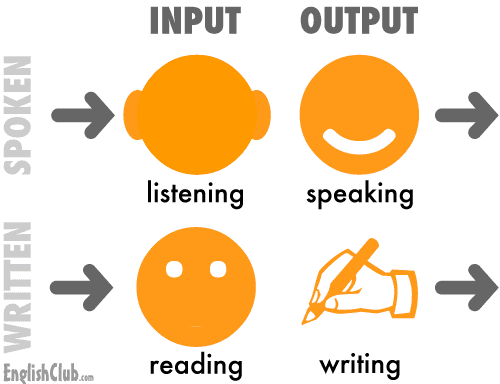Structure of a Specific Academic Text/Reading and Analyzing Academic Text
Hello, learners. In this session we will be discussing the four macro skills and the two categories of language skills :
When we learn a language, there are four skills that we need for complete communication. When we learn our native language, we usually learn to listen first, then to speak, then to read, and finally to write. These are called the four "language skills":

The four macro skills
The four language skills are related to each other in two ways:
- the direction of communication (in or out)
- the method of communication (spoken or written)
Note that these four language skills are sometimes called the "macro-skills". This is in contrast to the "micro-skills", which are things like grammar, vocabulary and pronunciation.
A. LISTENING- is receiving language through the ears. Listening involves identifying the sounds of speech and processing them into words and sentences.

B. SPEAKING- is the delivery of language through the mouth. To speak, we create sounds using many parts of our body, including the lungs, vocal tract, vocal chords, tongue, teeth and lips.
C. READING- is the process of looking at a series of written symbols and getting meaning from them.

D. WRITING- is the process of using symbols (letters of the alphabet, punctuation and spaces) to communicate thoughts and ideas in a readable form.

TWO CATEGORIES OF LANGUAGE SKILLS
RECEPTIVE SKILLS -has something to do with how you interpret what your senses received. | PRODUCTIVE SKILLS -allow you to produce something that you want to communicate to others. | ||||||||||||
Listening | Writing | ||||||||||||
Reading ANALYZING ACADEMIC TEXTTWO STRATEGIES 1. Using Context Clues 2. Analyzing word structure ================================================================================= 1. USING CONTEXT CLUES I. Context Clues • are the words or sentences surrounding the unfamiliar word that give hints on its meaning • used to guess the meaning of an unfamiliar word; a strategy to improves one's reading skill.
Example: Piscatorial creatures, such as lounder, salmon, and trout, live in the coldest parts of the ocean. “Piscatorial” obviously refers to fish. The lugubrious wails of the gypsies matched the dreary whistling of the wind in the all but-deserted cemetery. “Lugubrious” which means sorrowful, fits into the mood set by the words “wails,” “dreary”, and “deserted cemetery.”
II. Synonym or Definition Clues • the meaning of an unfamiliar word is given in the sentence if a similar word is also used to make the meaning clearer. • Signal words for synonym clues are or, in other words, that is, by this we mean, that is to say, and also known as.
Example: Caught in an epiphany, that is, a sudden, strong, and clear realization, I suddenly knew how to solve my dilemma. The word epiphany is defined as “a sudden, strong and clear realization” with the signal word “that is” as a hint.
III. Antonym or Contrast Clues • the meaning of an unfamiliar word is given in the sentence if an opposite word is used to suggest the meaning. • Signal words for antonym clues are but, however, on the other hand, nevertheless, yet, and ij contrast.
Example: Jogging long distance exacerbates the pain in my feet. However, soaking my feet in warm water after jogging feels relaxing and soothing. Exacerbates means “to aggravate” or “increase the pain”; the signal word however signifies opposite.
IV. General Clues • making sense of a word's meaning by largely depending on your common sense requires you to use your knowledge and experience.
Example: Paul knew he just made a cultural faux pas when he kissed the Muslim woman on the cheek and he was met with a dead, stunned stare. (If you have a prior knowledge about the Muslim culture, you would know that it is conservative in the sense that there should be no physical contact between people of the opposite gender.) Faux Pas refers to committing a mistake or an unacceptable action. Dead, stunned stare is an indicator that the action of kissing is not acceptable based on your prior knowledge and that this expression is a mark of displeased behavior or reaction.
2. WORD STRUCTURE • composed of three parts a. Prefix b. Root word c. Suffix Example: Unisolated Un (prefix) isolate (root word) -ed (suffix) • the parts of a word in English have meanings based on their origin, which could be Latin, Greek, and French, to name a few. PREFIX - are letters which we add to the beginning of a word to make a new word with a different meaning – to attach before a word – Pre means “before” fix “to attach” – there are negative prefixes such as un-, non-, on-, and dis- – show location such as tele-, sub-, and trans- – show numbers or amounts such as mono-, bi-, multi-, and deca- Examples:
SUFFIX – usually change a word from one form or part of speech (e.g., noun, verb, and adjective) to another form. – A verb can become a noun when you add suffix Example: memory-nour memorable-verb
F. Root Word • root word in modern English are easy to spot. Examples: Aimless- aim Unloved- loved Joyful- joy • however, many root words in English that originated from Latin, Greek and other languages are difficult to spot. G. Denotation • refers to the real meaning of a word. Example: Snake- is “betrayal, evil, or danger” I. Connotation • refers to implied meaning Example: ''This heart of mine is yours now and forever.'' (Does one really take out his or her heart and give it to someone else?) | Speaking |

I understand this lesson today
ReplyDelete